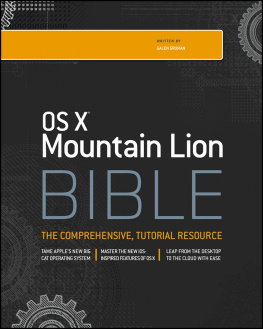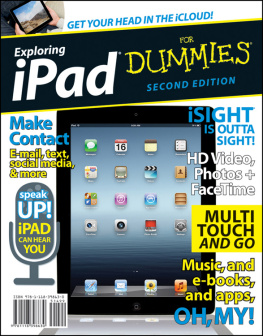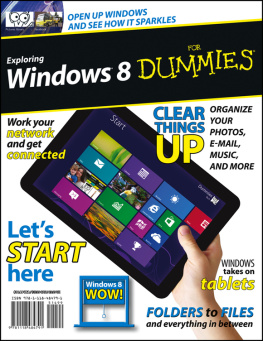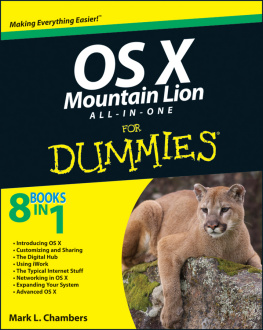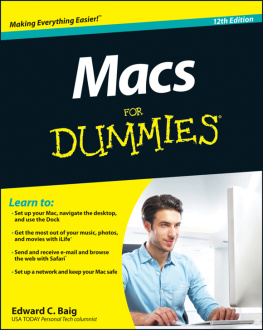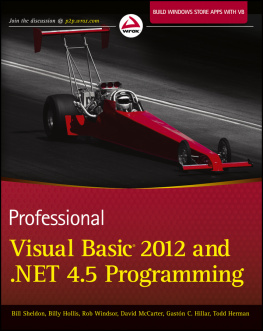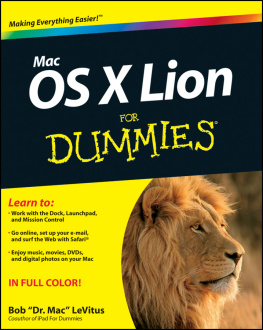OS X Mountain Lion Bible
Galen Gruman
OS X Mountain Lion Bible
Published by John Wiley & Sons, Inc. 10475 Crosspoint Boulevard Indianapolis, IN 46256 www.wiley.com
Copyright 2012 by John Wiley & Sons, Inc., Indianapolis, Indiana
Published by John Wiley & Sons, Inc., Indianapolis, Indiana
Published simultaneously in Canada
ISBN: 978-1-118-40143-9
Manufactured in the United States of America
10 9 8 7 6 5 4 3 2 1
No part of this publication may be reproduced, stored in a retrieval system or transmitted in any form or by any means, electronic, mechanical, photocopying, recording, scanning or otherwise, except as permitted under Sections 107 or 108 of the 1976 United States Copyright Act, without either the prior written permission of the Publisher, or authorization through payment of the appropriate per-copy fee to the Copyright Clearance Center, 222 Rosewood Drive, Danvers, MA 01923, (978) 750-8400, fax (978) 646-8600. Requests to the Publisher for permission should be addressed to the Permissions Department, John Wiley & Sons, Inc., 111 River Street, Hoboken, NJ 07030, 201-748-6011, fax 201-748-6008, or online at http://www.wiley.com/go/permissions .
Limit of Liability/Disclaimer of Warranty: The publisher and the author make no representations or warranties with respect to the accuracy or completeness of the contents of this work and specifically disclaim all warranties, including without limitation warranties of fitness for a particular purpose. No warranty may be created or extended by sales or promotional materials. The advice and strategies contained herein may not be suitable for every situation. This work is sold with the understanding that the publisher is not engaged in rendering legal, accounting, or other professional services. If professional assistance is required, the services of a competent professional person should be sought. Neither the publisher nor the author shall be liable for damages arising herefrom. The fact that an organization or Web site is referred to in this work as a citation and/or a potential source of further information does not mean that the author or the publisher endorses the information the organization or Web site may provide or recommendations it may make. Further, readers should be aware that Internet Web sites listed in this work may have changed or disappeared between when this work was written and when it is read.
For general information on our other products and services or to obtain technical support, please contact our Customer Care Department within the U.S. at (877) 762-2974, outside the U.S. at (317) 572-3993 or fax (317) 572-4002.
Library of Congress Control Number: 2012946055
Trademarks: Wiley, the Wiley logo, and related trade dress are trademarks or registered trademarks of John Wiley & Sons, Inc. and/or its affiliates, in the United States and other countries, and may not be used without written permission. OS X and Mac are registered trademarks of Apple, Inc. All other trademarks are the property of their respective owners. John Wiley & Sons, Inc., is not associated with any product or vendor mentioned in this book. OS X Mountain Lion Bible is an independent publication and has not been authorized, sponsored, or otherwise approved by Apple, Inc.
John Wiley & Sons, Inc. also publishes its books in a variety of electronic formats and by print-on-demand. Some content that appears in standard print versions of this book may not be available in other formats. For more information about John Wiley & Sons, Inc., products, visit us at www.wiley.com .
Dedication
To my friend Ken, one of the nicest, most enthusiastic, and most helpful guys there is.
And a toast to the late Steve Jobs and everyone at Apple past and present who has made OS X the wonderful example of how technology that actual people use should work.
Galen Gruman
About the Author
Galen Gruman is the principal at The Zango Group, an editorial development and book production firm. As such, he has produced books for Wiley. He also is author or coauthor of 28 books on desktop publishing, as well as author of the Mac OS X Lion Bible , iBooks Author For Dummies , and Exploring iPad For Dummies . Gruman has covered Macintosh technology for several publications, including the technology website InfoWorld.com, for which he began writing in 1986 and of which he is now executive editor, and Macworld, whose staff he was a member of from 1991 to 1998.
Credits
Acquisitions Editor
Aaron Black
Project Editor
Martin V. Minner
Technical Editor
Paul Sihvonen-Binder
Copy Editor
Gwenette Gaddis
Editorial Director
Robyn Siesky
Business Manager
Amy Knies
Senior Marketing Manager
Sandy Smith
Vice President and Executive Group Publisher
Richard Swadley
Vice President and Executive Publisher
Barry Pruett
Project Coordinator
Katie Crocker
Graphics and Production Specialists
Carrie Cesavice Jennifer Creasey Jennifer Mayberry
Quality Control Technician
Melissa Cossell
Proofreading and Indexing
John Greenough BIM Indexing & Proofreading Services
Introduction
For those who've used the Mac since the mid-1980s as I have, it's hard to believe that it's been more than 11 years since the first desktop version of OS X (10.0 Cheetah) was released, in March 2001, at a period when Apple's very survival seemed uncertain after years of chaotic management. Returned CEO Steve Jobs changed that chaos into focus and innovation, and a steady stream of improved OS X big cats have followed: Mac OS X 10.1 Puma in September 2001, Mac OS X 10.2 Jaguar in August 2002, Mac OS X 10.3 Panther in October 2003, Mac OS X 10.4 Tiger in April 2005, Mac OS X 10.5 Leopard in October 2007, Mac OS X 10.6 Snow Leopard in August 2009, and Mac OS X 10.7 Lion in July 2011.
After just a year's rein, the king of the jungle cedes the Mac crown to OS X 10.8 Mountain Lion, a refinement to OS X Lionand the first version of OS X to formally drop the Mac part of the name, though Apple often informally dropped it in OS X Lion.
OS X Mountain Lion moves OS X (pronounced Oh Ess Ten, by the way) further in the direction set by Lionthe post-PC world in which smartphones, tablets, and computers coexist and in fact form a constellation of devices used by the same person. It's a vision that the late Steve Jobs had for years, and he lived to see really take root with the success of the iPhone and iPad, and the launch of the iCloud service just before he died that ties so much of it together.
OS X Mountain Lion deepens the use of iCloud, bringing the online syncing service into the world of cloud storage, so applications can open and store files directly on iCloud. And Safari can even show you the web pages you were using on your other Mac or iOS device, so you can pick up where you left off as you move from one device to another, whether at home, at the office, or between the two.
But OS X Mountain Lion also adopts another form of collaboration that Apple has pushed aggressively in the iOS operating system used in the iPhone, iPad, and iPod Touch: share sheets that make it easy to share URLs, files, and more over Twitter, Facebook, e-mail, AirDrop, and other services. In the same sharing vein, the new Messages application takes the old iChat software and adds a free SMS-like service to connect OS X and iOS users.
And, because Apple is Apple, you'll see dozens of subtle improvements in OS X Mountain Lion that make it easier, more capable, and just better. That also means dropping technologies that have fallen into disuse, such as the RSS capabilities in Mail and Safari. Like a good gardener, Apple knows that you have to prune, not just plant. (Appendix B describes all the changes.)

